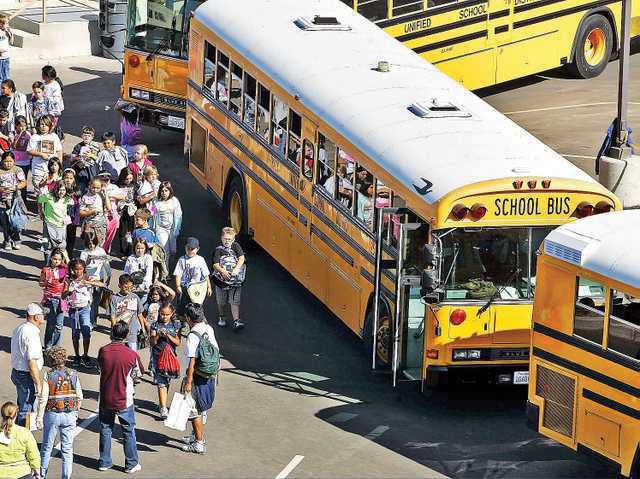Should Gov. Jerry Brown sign legislation requiring school buses to have alarms to avoid students being left on board it will simply reaffirm one of three safety protocol redundancies already in place on Manteca Unified buses.
Senate Bill 1072 that passed the California Legislature last week and is awaiting Brown’s decision requires a child safety alarm to be placed at the back of all school buses. The alarm is triggered whenever the engine is turned off. The driver has to walk to the back of the bus to turn it off.
“We are not (currently) mandated to have the alarm system in the back of the bus,” Manteca Unified Superintendent Jason Messer noted. “However, currently at the end each run, the bus driver walks to the rear of the bus (on the inside) and resets the alarm.”
That is in addition to bus drivers being required to pull over to a safe location after the last students is dropped off at the end of a bus run. They then have to do a visual walk-through inside the bus to make sure no students are on board.
Then when the bus is returned to the district yard and before they can disembark, drivers perform a student check with a Zonar hand-held device. The devise is used to scan various students “check asset tags.” Once scanned, the information is logged in electronically.
The Senate Bill that had no opposition came after 19-year-old autistic student Paul lee of Whitter died after being left for hours on a hot school bus on a 90-degree day.
When the driver — a substitute who thought Lee had disembarked at a high school stop on the morning ruin — found him unconscious when preparing to take the bus out in the afternoon. Lee later died.
Messer said the district hasn’t any issues with students left on buses for years.
“It used to happen every once in a while,” Messer said. “A student might be tired after the end of school. They’d get on the bus where it might be warmer and the rocking motion would put them to sleep.”
The three safety protocols in place were done to eliminate that from happening.
Manteca Unified has a long history of staying on the cutting edge of bus safety.
Back in the 1990s, they were the second school district in the state to equip buses with flashers designed specifically to make them more visible in fog.
Fog day procedures are designed so that the transportation supervisor can determine well in advance of the scheduled run of buses whether there will be a delay due to visibility. Parents are notified by an automated phone program.
“What we don’t want are parents sending their kids out to bus stops in the fog when buses are delayed,” Messer said.
He noted kids have a tendency to horse around. Such behavior in fog along roads is extremely dangerous.
Every September the district conducts bus evacuation drills at the 30 Manteca Unified school sites when the bus arrives at the campus to drop students off. The drills this year are Sept. 26-27.
Divers are mandated to have 10 hours of training per year. They must take a renewal class for their license and certificate every five years.
The district has a fleet of 74 school buses. There are20 special education routes and 16 regular education routes.
The district transports 1,350 students on a daily basis to and from school.
During the 2013-2014 school year, district buses traveled 1,325,424 miles. That’s the equivalent of going to the moon (238,857 miles) and back 2.7 times every year.
To contact Dennis Wyatt, email dwyatt@mantecabulletin.com
MUSD: Ahead of the curve
Buses already equipped with student safety bus alarms





